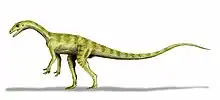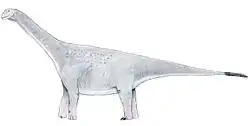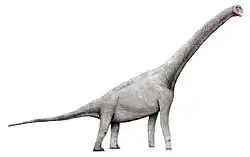| Maxakalisaurus Temporal range: Late Cretaceous | |
|---|---|
 | |
| Reconstructed skeleton | |
| Scientific classification | |
| Domain: | Eukaryota |
| Kingdom: | Animalia |
| Phylum: | Chordata |
| Clade: | Dinosauria |
| Clade: | Saurischia |
| Clade: | †Sauropodomorpha |
| Clade: | †Sauropoda |
| Clade: | †Macronaria |
| Clade: | †Titanosauria |
| Clade: | †Lithostrotia |
| Genus: | †Maxakalisaurus Kellner et al., 2006 |
| Species: | †M. topai |
| Binomial name | |
| †Maxakalisaurus topai Kellner et al., 2006 | |

Maxakalisaurus is a genus of titanosaur dinosaur, found in the Adamantina Formation of Brazil, in the state of Minas Gerais in 1998. The genus name is derived from the tribe of the Maxakali; Topa is one of their divinities.[1]
Description
The type specimen of Maxakalisaurus belonged to an animal about 12.1 meters (40 feet) long, with an estimated weight of 5 tonnes (5.5 short tons).[1][2] It had a long neck and tail, ridged teeth (unusual among sauropods) and lived about 80 million years ago. Because sauropods seem to have lacked significant competition in South America, they evolved there with greater diversity and more unusual traits than elsewhere in the world.[1] Like the fellow titanosaur Saltasaurus, Maxakalisaurus had defensive osteoderms; one has been found on the holotype.
In 2016, a new specimen comprising a dentary and teeth was described as belonging to Maxakalisaurus. [3]
The holotype of Maxakalisaurus topai was housed at the National Museum of Brazil.[1][4] Some elements of the holotype were lost in the National Museum of Brazil fire on 2 September 2018, but several elements survived the fire and were recovered.[5]
Classification
França et al.'s 2016 description of the second specimen also included a phylogenetic analysis, which placed Maxakalisaurus as a basal member of the Aeolosaurini. Their cladogram is shown below:[3]
| Lithostrotia |
| |||||||||||||||||||||||||||||||||||||||||||||||||||||||||||||||||||||||||||||||||||||||||||||
References
- 1 2 3 4 Kellner, Alexander W. A.; Campos, Diogenes de Almeida; de Azevedo, Sergio A. K.; Trotta, Marcelo N. F.; Henriques, Diese D. R.; Craik, Maureen M. T.; Silva, Helder de Paula (2006-08-11). "On a new titanosaur sauropod from the Bauru Group, Late Cretaceous of Brazil". Boletim do Museum Nacional, Nova Série, Geologia. 74: 1–31. ISSN 0080-3200.
- ↑ Paul, Gregory S. (2010). The Princeton Field Guide to Dinosaurs. Princeton University Press. p. 212.
- 1 2 França, M.A.G.; Marsola, J.C.d A.; Riff, D.; Hsiou, A.S.; Langer, M.C. (2016). "New lower jaw and teeth referred to Maxakalisaurus topai (Titanosauria: Aeolosaurini) and their implications for the phylogeny of titanosaurid sauropods". PeerJ. 4: e2054. doi:10.7717/peerj.2054. PMC 4906671. PMID 27330853.
- ↑ BBC (3 September 2018). "Brazil National Museum fire: Key treasures at risk". BBC News. Retrieved 4 September 2018.
- ↑ Brum, Arthur S.; Bandeira, Kamila L.N.; Sayão, Juliana M.; Campos, Diogenes A.; Kellner, Alexander W.A. (2022-04-01). "Microstructure of axial bones of lithostrotian titanosaurs (Neosauropoda: Sauropodomorpha) shows extended fast-growing phase". Cretaceous Research: 105220. doi:10.1016/j.cretres.2022.105220. ISSN 0195-6671.
- Santucci, R. M. & Bertini, R.J. (2006). "A large sauropod titanosaur from Peirópolis, Bauru Group, Brazil." N. Jb. Geol. Paläont. Mh., 2006: 344-360; Stuttgart.
External links
- Brazil's Biggest Dinosaur Unveiled - LiveScience.com











